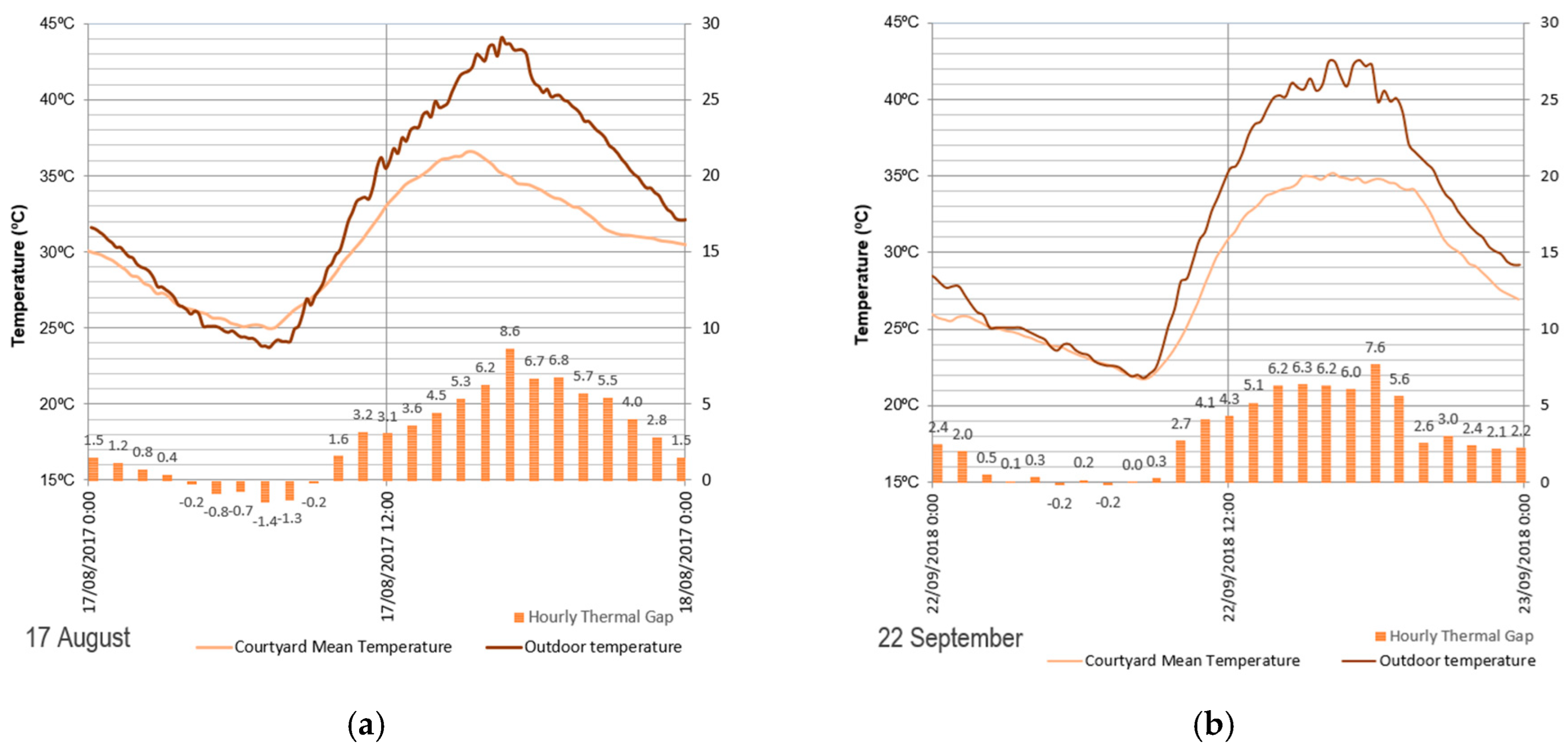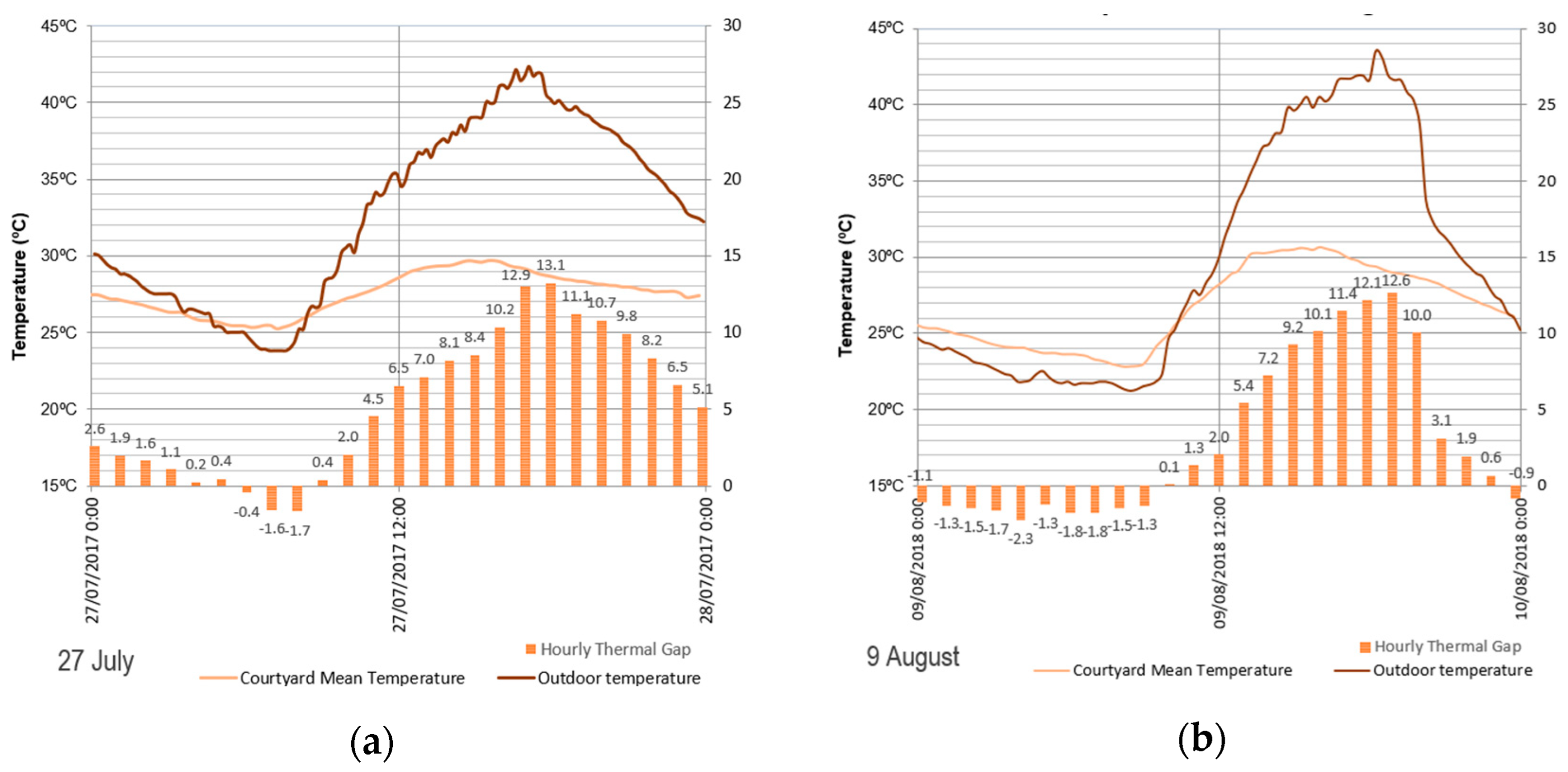1. Introduction
Climate change is one of the main challenges we face nowadays, one of its consequences being the increase in the temperature of the planet [
1]. Another effect is the escalation in the Urban Heat Island effect in cities, which detriments the thermal comfort of people and increases the energy consumption of buildings to meet their needs [
2]. CO2 emissions are one of the main causes of climate change [
3] and buildings are responsible for 40% of these CO2 emissions in Europe [
1]. The reduction of energy consumption in buildings is, therefore, a necessity in order to achieve the Sustainable Development Objectives and a habitable future world.
Traditional architecture typologies include many passive strategies to condition buildings. One of the most used in the Mediterranean climate is the use of the courtyard, elements that temper the outdoor climate by means of the thermodynamic effects that occur inside them. Many factors influence the performance of the courtyards, not only their geometry but also other elements that can be modified such as the presence of vegetation, water, shading devices or the albedo of the surfaces [
4]. It is important to clarify the influence of each of these factors in order to understand how the courtyard works and being able to improve or design the best possible buildings.
This study focuses on the analysis of the performance of two courtyards with different geometries where a shading device has been installed. The geometry of the courtyard is described by means of the aspect ratio, which is the relation between the height of the courtyard and its width The aim of the study is to determine if the geometry plays an important role when a shading device is installed and measure the effectiveness of this strategy in the hot and dry climate of the south of Spain. The variable analyzed to compare the effectiveness of the courtyard is the thermal gap at each hour, which is defined as the difference between the outdoor temperature and the courtyard’s temperature. The higher the thermal gap comparing the courtyard with and without the shading device, the more effective the strategy is.
2. Materials and Methods
Two case studies have been selected to be monitored with and without a shading device in the Mediterranean climate, in the cities of Cordoba and Seville. According to Köppen climate classification they are located in an area Csa which involves hot dry summers with mean temperatures of 28 °C and temperate winters in which the mean temperature is above 9 °C. Among all the days monitored, two days for each courtyard configuration have been selected, one with warm temperatures (35 °C < T < 40 °C) and another with extremely hot temperatures (>40 °C).
2.1. Courtyard Description
The two courtyards have been selected to analyze the influence of the shading device in different geometries, but the same climate and similar orientation.
Courtyard A (
Figure 1a): This courtyard’s floor plan is 4.3 × 4.0 m and it has a height of 6.3. This means an Aspect Ratio of 1.57 and 1.46 respectively. It belongs to a refurbished traditional patio-house in Córdoba.
Courtyard B (
Figure 1b): This second courtyard belongs to an educational building in Seville. It has a floor plan of 6.9 × 5.2 m and a height of 5 m, which means an Aspect Ratio of 0.72 and 0.96, which is half of the previous courtyard, in order to analyze the influence of the courtyards’ depth.
Figure 1.
Images of the courtyards: (a) Courtyard A in Córdoba; (b) Courtyard B in Seville.
Figure 1.
Images of the courtyards: (a) Courtyard A in Córdoba; (b) Courtyard B in Seville.
Both courtyards have similar walls finished, white color mortar coating and some windows. The same shading device has been installed in both courtyards, consisting of a black canvas mesh installed in the top of the courtyard, leaving some separation with the walls to allow convection flows. The fabric of the canvas cover is black polyethylene of 60–70% UV filter and 70 g/m2 density.
2.2. Monitoring
The monitoring campaigns have been carried out during the warmest months of the Mediterranean climate, July, August, and September. In order to quantify the influence of the shading element in the temperature of the courtyard for different outdoor temperature ranges, one representative day of warm temperatures (between 35 °C and 40 °C) and one day of extreme temperatures (more than 40 °C) have been selected for each courtyard and each situation, with and without shading device installed.
The monitored data has been collected using a weather station model PCE-FWS 20 that provides outdoor temperature, humidity and wind speed. It was located on the roof of each building. For the temperature in the courtyard, sensors TESTO 174 T were used, located at a livable height (1.5 m) and protected from solar radiation with shields.
3. Results
3.1. Unshaded Monitoring
Figure 2 shows the monitored results in both courtyards when there was no shading device installed for the extremely hot temperature day (>40 °C) and
Table 1 shows both, the values for the warm and the hottest days. Despite the different Aspect Ratio in the courtyard, a very similar performance can be seen. When the temperature is warm in the outdoor, the courtyards’ temperature is only a few degrees below (maximum of 3 °C), and only in the hottest hours of the day.
However, when the outdoor temperature rises up to 40 °C, the tempering effect of both courtyards is much more important. Both courtyards achieve up to a 6 °C difference between the courtyard and outdoor temperature in the hottest hours of the day. In this case, the performance of the Courtyard A is moderately better, which can be explained by its deeper geometry that reduces the solar radiation in the walls of the courtyard.
Figure 2.
Outdoor and Courtyard temperature and Thermal Gap without shading device (a) Courtyard A in Córdoba; (b) Courtyard B in Seville.
Figure 2.
Outdoor and Courtyard temperature and Thermal Gap without shading device (a) Courtyard A in Córdoba; (b) Courtyard B in Seville.
3.2. Shaded Monitoring
Figure 3 shows outdoor temperature and courtyard temperature, as well as the thermal gap each hour for a representative hot day with the shading device installed. It can be noticed that the performance of the courtyard in this case is much better in both cases. The effect of the shading device is dramatically important when temperatures are more than 40 °C, the thermal gap rises more than 12 °C in both case studies. Another fact that can be seen in the performance of the courtyards with a shading device is the increase in the overheating of both courtyards during the night. However, this aspect is not detrimental and it could be avoided removing the shading device during the night.
Table 1 summarizes the maximum thermal gap achieved in each courtyard in each one of the cases described before. It is possible to see almost the double thermal gap between each courtyard with a shading device and no shading device. Courtyard A performs slightly better than B, which makes sense being a deeper courtyard, with an aspect ratio of 1.5, twice the aspect ratio of courtyard B. However, the geometry has clearly less influence than the presence of the shading device in the courtyard.
4. Conclusions
The results obtained in this study prove the huge improvement of the courtyard performance when a shading device is installed. Furthermore, the higher the outdoor temperature, the higher the thermal gap between outdoor and courtyard temperature, which means that the strategy of the shading device will be effective even in the future of climate change that we are facing. What is more interesting is the fact that the different geometry does not have a big influence in the final performance of the shaded courtyards, which means that any existing courtyard could benefit from the installation of this devices, being an excellent strategy in the renovation of buildings. However, the monitoring campaigns of this study are very limited, and more examples should be monitored in order to reinforce these conclusions.
Author Contributions
C.G.-M. and C.R.-G. conceived and designed the experiments; V.P.L.-C. performed the experiments and analyzed the data; V.P.L.-C., C.G.-M. and C.R.-G. wrote the paper.
Acknowledgments
This work has been supported by the National Government of Spain Research Project MTM2015-64577-C2-2-R. The authors thank AEMET (State Meteorological Agency) for the data supplied.
Conflicts of Interest
The authors declare no conflict of interest. The funders had no role in the design of the study; in the collection, analyses, or interpretation of data; in the writing of the manuscript, or in the decision to publish the results.
References
- Core Writing Team, R.K.; Pachauri; Meyer, L.A. (Eds.) IPCC, 2014: Climate Change 2014: Synthesis Report; Contribution of Working Groups I, II and III to the Fifth Assessment Report of the Intergovernmental Panel on Climate Change. IPCC: Geneva, Switzerland, 2014. [Google Scholar]
- Santamouris, M.; Papanikolaou, N.; Livada, I.; Koronakis, I.; Georgakis, C.; Argiriou, A.; Assimakopoulos, D.N. On the impact of urban climate on the energy consumption of building. Sol. Energy 2001, 70, 201–216. [Google Scholar] [CrossRef]
- Matthews, H.D.; Gillett, N.P.; Stott, P.A.; Zickfeld, K. The proportionality of global warming to cumulative carbon emissions. Nature 2009, 459, 829. [Google Scholar] [CrossRef] [PubMed]
- Ghaffarianhoseini, A.; Berardi, U.; Ghaffarianhoseini, A. Thermal performance characteristics of unshaded courtyards in hot and humid climates. Build. Environ. 2015, 87, 154–168. [Google Scholar] [CrossRef]
© 2020 by the authors. Licensee MDPI, Basel, Switzerland. This article is an open access article distributed under the terms and conditions of the Creative Commons Attribution (CC BY) license (http://creativecommons.org/licenses/by/4.0/).









